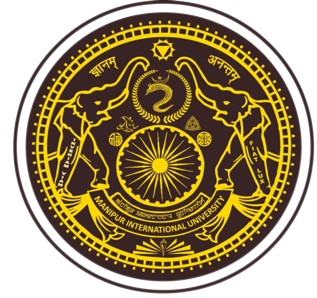
MIU LOGO
know more...
The Logo of the Manipur International University is used by the MIU to represent the University in all of its official correspondences, certificates, website etc. The logo portrays two elephants guarding the Ashoka Chakra representing the Dharma Chakra (Wheel of Dharma; a wheel represented with 24 spokes symbolically representing the Dharma, the right way of living, cosmic law and order, four noble truths of life by Lord Buddha or simply the life) and Ancient shortened version of Pakhangbha Paphal representing the supreme God of the Meitei tradition of State of Manipur.
The logo also contains the following:
- “Jnanam Anantam” a phrase in Sanskrit written in Devanagari script meaning “Knowledge is Infinite”.
- “Fiat Lux” is a phrase in Latin which means “Let there be light” in English which can also be found in Rigveda and also in Book of Genesis which is part of Hebrew Bible. This word is considered divine and has exerted a powerful influence on the English poetic tradition.
- “Inveniam Viam” which means “I shall find a way” in English. This is taken from the ancient latin verse “Aut inveniam viam aut faciam”; which means “I shall either find a way or make one”.
- A “Trinity Knot” which is also called Triquetra is an ancient symbol known for its versatility. It represents various things in various cultures like Father, Son and Holy Spirit / Past, Present and Future / creation, innocence and wisdom/ goodness of nature as mother, maiden and crone etc. It is also believed to be symbol of luck and longevity.
- A representation of the Symbol called “Lu” which is an auspicious Chinese symbol which looks like Hindu Swastik and it stands for prosperity, fortune and wealth
- A representation of the Symbol called “Fu” which is an auspicious Chinese symbol for good luck, fortune and Blessing.
- A symbolic representation of a Head of Rhino is a symbol of gentleness, unconventional behaviour, peaceful personalities, steadiness, power and agility.
- A “Shankha” – a conch shell which is sacred emblem of the Hindu preserver of God Vishnu and also has a great ritual/religious significance in Hinduism and Buddhism. The Shankha is praised in Hindu Scriptures as a giver of fame, longevity and prosperity, the cleanser of sin and the abode of goddess Lakshmi, who is the goddess of wealth and consort of Lord Vishnu.
- A symbolic representation of “Manipura” which is the third primary chakra according to vedic tradition. Manipur is associated with fire and the power of transformation.
- It has two elephants facing each other with their trunks upwards. The elephant is associated with the Buddha and the Indian deity Lord Ganesha and it is used to symbolize power, wisdom, strength, protection of the home, fertility, leadership, and general good luck. Their trunks facing upwards also represents prosperity, good luck, knowledge and academic success in general.
- The Outer wheel also symbolises Dharma Chakra and it also means progress is being or continues to be made in life or simply it symbolises the life cycle.
- Other elements: Two banners below the shield, each for carrying the words “Manipur International University’ in Meitei Mayek (Manipuri Script) and in English respectively. This logo is used in all the certificates, stationary, mementos and on exteriors of all the buildings of the University.
Manipur International University
MIU HQ, Ghari Awang Leikai, Airport Road, Imphal West
manipur -795140
About MIU
The Manipur International University (MIU) is an Autonomous State Statutory International University. It is established, recognized, and institutionally accredited by the State Government of Manipur. It is recognized and listed by the University Grants Commission (UGC), Ministry of Education, Government of India under section 2(f) of UGC Act, 1956 as a State Private University. It is empowered to award degrees under section 22 of the UGC Act, 1956. It has been declared as an “International Institution of Excellence,” an “Institution of State Importance,” and “State Research Institute” by the State.
Reach us
# +918899788788